Eurocom Racer: Why the Radeon HD 6970M Rocks
by Jarred Walton on March 17, 2011 3:00 AM ESTMobile Sandy Bridge: Why You Don’t Need a Desktop
As usual, we’ll start with our application results. Sandy Bridge is fast on the desktop, particularly if you’re an enthusiast interested in overclocking; shift over to the mobile world and the quad-core versions are downright revolutionary. The only fly in the ointment here is that with the use of a discrete GPU and no switchable graphics, users lose access to Intel’s Quick Sync technology. I’ve been using that to encode videos for the family, and the result is several times faster than even my overclocked i7-965 system. Then again, I usually just start the encode/upload task and walk away; besides, the video editing process is far more time intensive than the encoding/uploading part, but I digress.
Here’s how the Eurocom Racer stacks up to the competition, and it’s going to look a lot like the other SNB i7-2630QM and i7-2720QM notebooks, albeit slightly faster than the former. The Eurocom results are in green, MSI's GT680R is in Red, and the Clevo P170HM is in black.
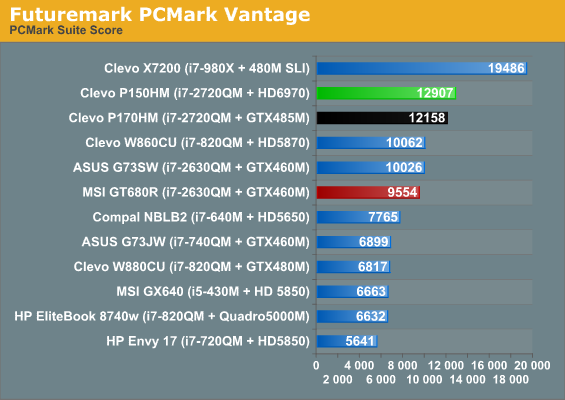

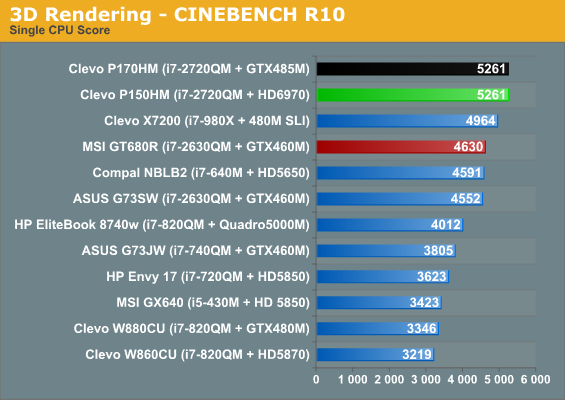
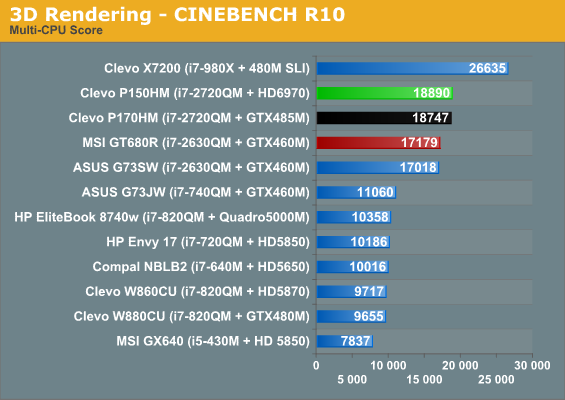
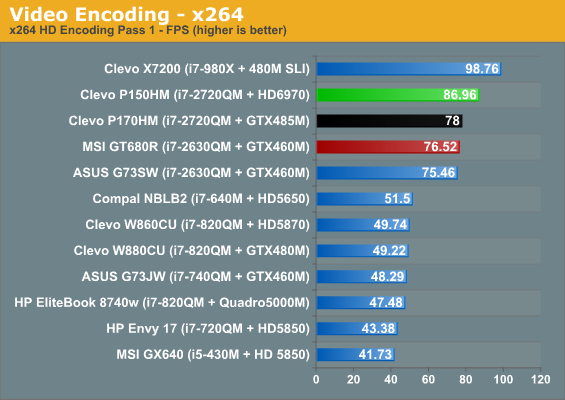
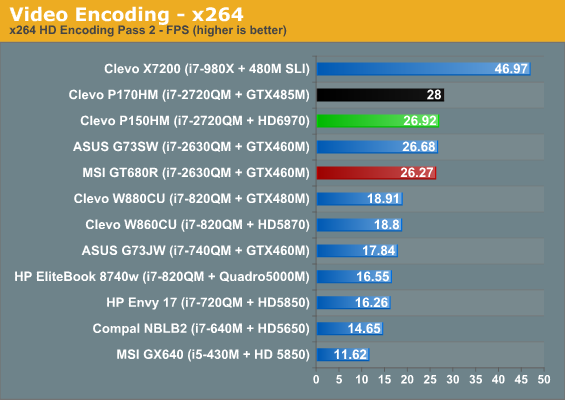
Even without an SSD, Sandy Bridge manages to pull out some impressive numbers. Interestingly, the P150HM, aka Racer, surpasses the larger P170HM in PCMark Vantage and PCMark05. How does it manage that without an SSD when the P170HM system includes a C300? Simple: it has a hybrid hard drive, the Seagate Momentus XT. Since we run PCMark (and all of our tests) more than once, the Momentus XT is able to optimize storage and put the frequently used apps into flash memory. An SSD will still be faster overall, but hybrid storage solutions can certainly close the gap and strike a nice balance of price, capacity, and performance. Now if we could just get a hybrid with more than 4GB of flash, I'd be happy.
Most of the remaining application benchmarks have the Racer and P170HM running neck and neck, though the first pass of x264 encoding shows another large margin of victory. It’s not clear if that’s another instance of the Momentus XT helping out, or if the 2720QM’s Turbo modes were just more successful in this instance, but the more intensive second pass puts things back where we’d expect. It does look to be more of the XT rather than Turbo Boost, as while the reported score is from the first of four consecutive runs (i.e. when Turbo is at its best), the worst results for x264 encoding are still 83.0 and 26.07. Let’s move on to 3DMark for a quick preview of graphics performance before we get to the actual gaming results.

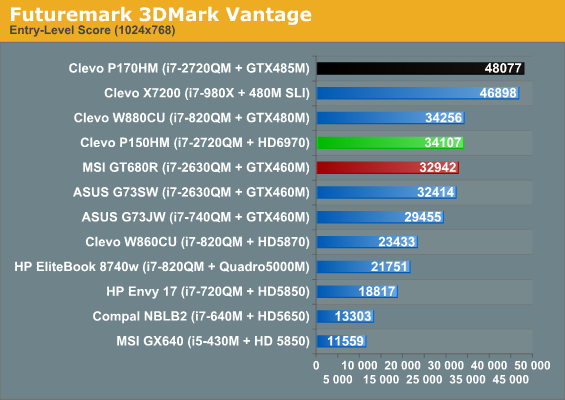
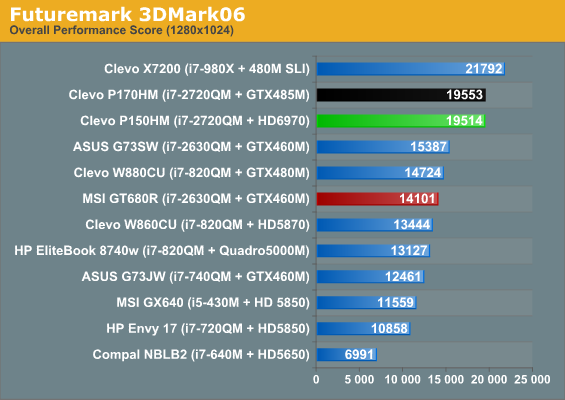
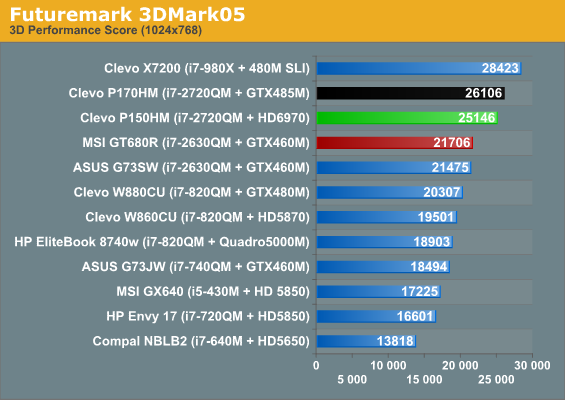
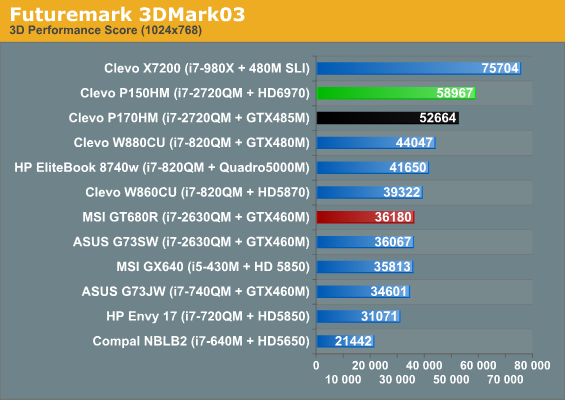
And this, folks, is why we don’t rely too heavily on 3DMark results. 3DMark almost raises more questions than answers, with the margin of victory for the GTX 485M ranging from 41% in Entry-Level Vantage to a tie in 3DMark06, and even a 12% loss in 3DMark03. We could say that gaming requirements are also variable, so just because one title happens to run well with NVIDIA doesn’t mean every title will go the same way, and that would be true. We can also throw out Entry Vantage and 3DMark03 as meaningless tests for this level of GPU; the Vantage Performance preset shows a much more reasonable 17% lead for the 485M.
On the other hand, one thing should be abundantly clear: given the apparently similar pricing, the 6970M is set to pummel the GTX 460M in most workloads. Outside of Entry Vantage and 3DMark03, the 6970M leads the fastest 460M system by at least 16% (3DMark05) and as much as 44% (Vantage Performance). But rather than guessing as to which version of 3DMark is the most meaningful for gamers, let’s just turn to some actual games.










47 Comments
View All Comments
freezervv - Thursday, March 17, 2011 - link
Re: "by Jarred Walton on 3/17/2011 3:00:00 AM"Or at least those of us ESTers just getting around to a catnap amidst exam studying. ;)
JarredWalton - Thursday, March 17, 2011 - link
Hey, I'm PDT, so it's only just past midnight. And here I thought I'd be finished with this about six hours ago....poohbear - Thursday, March 17, 2011 - link
hello, can you guys please list the price or price segment of the product u're reviewing from the get go? Do i really hafta scroll all the way to the back to get an idea of what the price range is, or if its a waste of time reading the article cause its out of said price range? U're constantly saying it costs more or this costs less, but there's no clear cut price easy for us readers to see. A comparison of similar products would be great too, in a clean easy to understand graph please and thank u!JarredWalton - Thursday, March 17, 2011 - link
Page one, bottom of the spec table, in bold. Was that not clear enough?chrnochime - Friday, March 18, 2011 - link
Bottom of the spec like Jarred said. Need that to be 3 or 4 larger font size?jcompagner - Thursday, March 17, 2011 - link
And then for SandyBridge?If only 1 17" is made with a 1920x1200p resolution on this planet that is not from apple, i would buy it immediately..
piroroadkill - Thursday, March 17, 2011 - link
Well, the Dell Precision M6500 has a 1920x1200 screen, 17".. and was reviewed on Anandtech.But it's not Sandy Bridge yet. I'd imagine a good supply of new Sandy Bridge chipsets aren't common, but I'd have no doubt at all Dell will do a refresh on their Precision line with Sandy Bridge at some point in the near future. It also looks about a million times better than the Clevo stuff, which looks like a ghetto kit machine.
bobsmith1492 - Thursday, March 17, 2011 - link
I bought a Sager back in 2005 with a 1920x1200 matte screen. It's still up and running, though relatively slow these days and a few things are broken now.blah238 - Thursday, March 17, 2011 - link
In my 3DMark Vantage settings, the "Performance" preset equates to 1280x1024, whereas "High" is 1680x1050. Did you have to use custom settings to get 1680x1050 or is there just a mixup of names?JarredWalton - Thursday, March 17, 2011 - link
Sorry, my mistake. I got the High default resolution of 1680x1050 confused with Performance. 1280x1024 panels are such a rarity these days that I was sure Vantage had switched to WS for everything. 3DMark11, interestingly enough, did shift to new resolutions. 1024x600 for Entry and 1600x900 for Performance I believe, with 1080p used at the High setting. About time...Now, if Futuremark would quit being idiots about changing my power settings every time I load one of their apps. Seriously: tweak all your power settings (i.e. don't put the LCD to sleep or hibernate the laptop after inactivity), then load any Futuremark app. When you're done, the power settings are now "display off after 5 minutes, ask for a password on resume, and hibernate/shut down with a low battery even when plugged in." Is it too much to think they should save my current settings and then restore them when the benchmark is done?